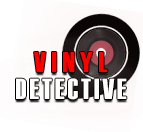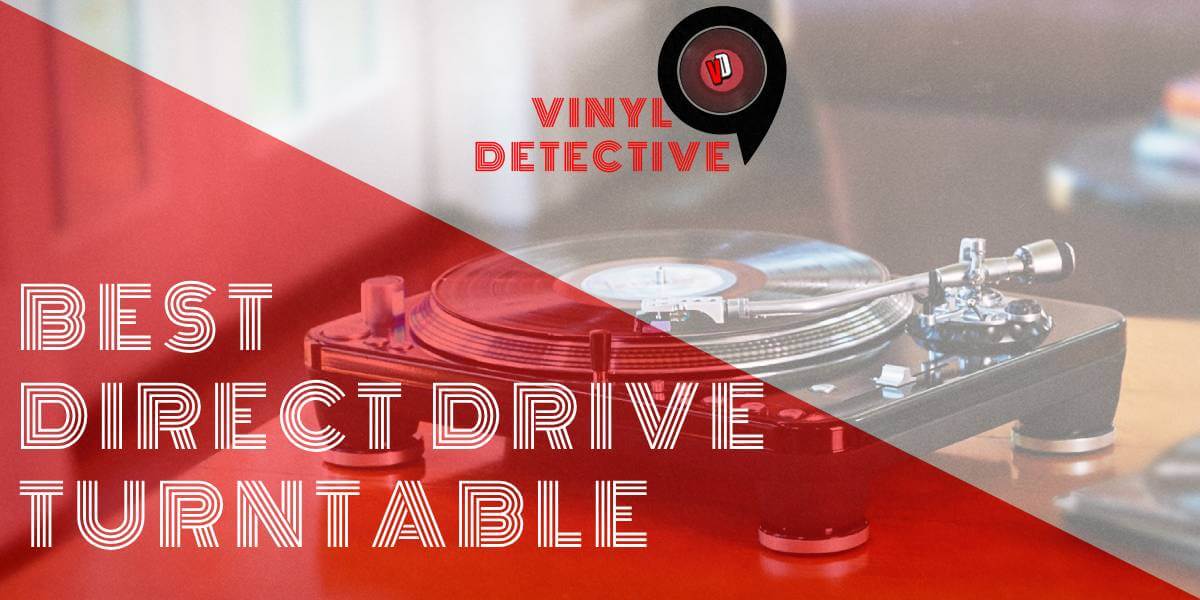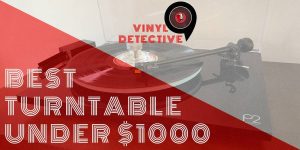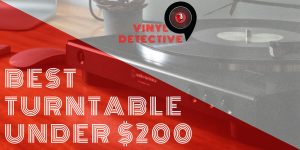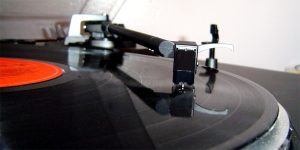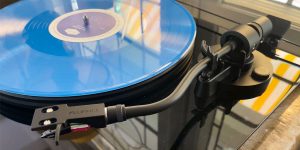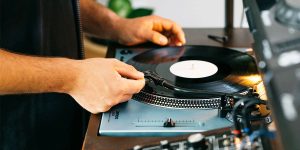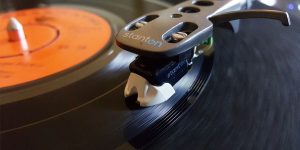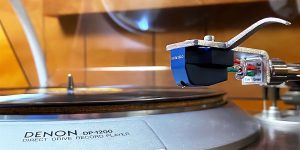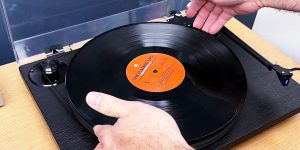In this article, I will search for the best direct-drive turntable. There is indeed a great demand for such models. And first of all, it would be logical to tell you why this type of drive is so interesting to users, wouldn’t it?
Well, direct drive came later than belt drive, which, in turn, is considered to be more authentic and natural for vinyl. But back then, they didn’t know anything about DJing yet. Nevertheless, you don’t have to be a professional remixer to appreciate the benefits of direct drive, and I’ll briefly tell you what it does.
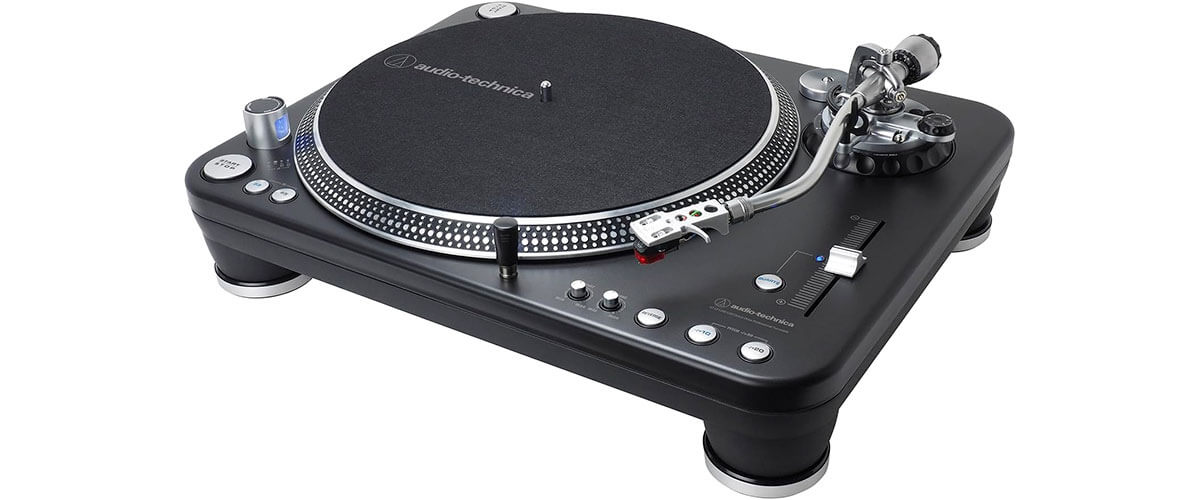
Turntables direct drive comparison table
| Name | Drive type | Operation type | Speeds | Phono Pre-Amp | Bluetooth | Review |
|---|---|---|---|---|---|---|
| Audio-Technica AT-LP1240-USBXP best overall | direct | manual | 33 1/3, 45, 78 RPM | yes | no | Review |
| Pioneer DJ PLX-1000 also great | direct | manual | 33 1/3, 45 RPM | no | no | Review |
| Technics SL-100C premium | direct | manual | 33 1/3, 45, 78 RPM | yes | no | Review |
| Reloop RP-2000 MK2 budget | direct | manual | 33 1/3, 45 RPM | yes | no | Review |
Benefits of direct drive turntables
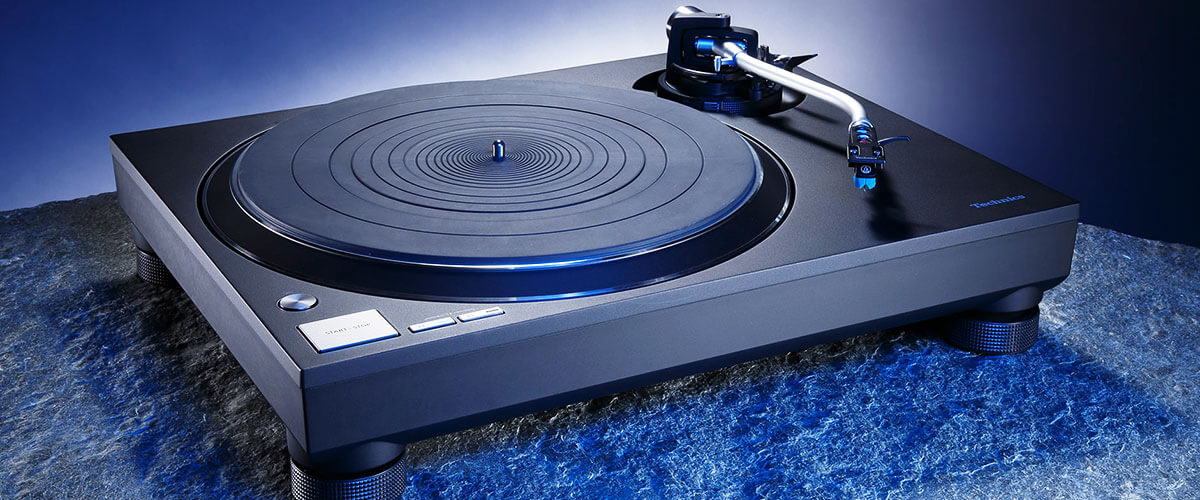
The direct drive motor sits directly underneath the record instead of on the side like belt-driven turntables. It, therefore, provides direct cooperation, which naturally results in more stable operation, regardless of the amount and speed of rotation. Consequently, you’ll get less wear and tear on parts, and your turntable, even if it is not the most expensive, will last a long time (this is beside the fact that the belt may break and need to be replaced). The third factor is lightning-fast torque, so you’ll get the acceleration you need from the first second (a belt drive takes some time).
All three are great for DJing, where every second counts; precision and instantaneous response to your actions are important. That’s why turntables with a direct drive motor often have controls right on the deck (EQ, speed switching, and so on). But even if you’re not going to mix tracks, your records will remain grateful.
It’s also worth noting that even though belt drive is considered quieter. Today, manufacturers produce excellent direct-drive turntables, providing a fairly quiet rotation.
Best direct drive turntable reviews
Audio-Technica AT-LP1240-USBXP – best overall

Guys, meet the absolute leader of my rating, which has won thousands of hearts and positive reviews from users worldwide in the mid-price segment. This is the Audio-Technica AT-LP1240-USBXP. First of all, I will never thank the manufacturer for the long, unpronounceable names. Secondly, at first glance at the turntable, it is clear that it was created for DJs.
Now, I’ll start describing the look and my impressions of the deck, but first, I’ll note that its look is attractive but not unique. You may be surprised, but out of the 4 reviewing turntables, 3 of them look just like twin brothers. So, in front of us, we have a plastic plinth weighing 27.6 (that’s just great for vibration resistance) on thick stable legs, on which there is a die-cast aluminum platter with DJ-style mat with Audio-Technica logo, S-shaped tonearm, and full control, including reverse, pitch control, gear change, start control and quartz lock (so there are more buttons, look at the photo and evaluate). So as not to go into a long excursion on each option, I will say that everything generally works perfectly (and I checked every button). However, it is worth honestly admitting that I am not a DJ (but I understand the principles, so I quite understand all the functions). I was impressed with the build quality, and considering the not the highest price of the turntable, I was satisfied (not the word). I especially like the VTA function because I understand the importance of setting the tone arm strictly parallel to the record, but most vinyl turntables in this segment (up to $1000) do not have it.
A couple of things confused me, although I’ll admit that while I was excited about the AT-LP1240-USBXP, I didn’t pay too much attention to the minor flaws. I’ll start with the anti-skating being a bit weak but not critical. This is not my first vinyl turntable from Audio-Technica, and I have yet to encounter perfect anti-skating from them. The second thing – more of a potential hazard – is the tonearm auto-lift feature. Maybe I’m just being over-insured, but if I were you, I would buy some damping fluid (let it lie around; it doesn’t spoil). Still, we are not discussing high-end decks, and there can be compromises.
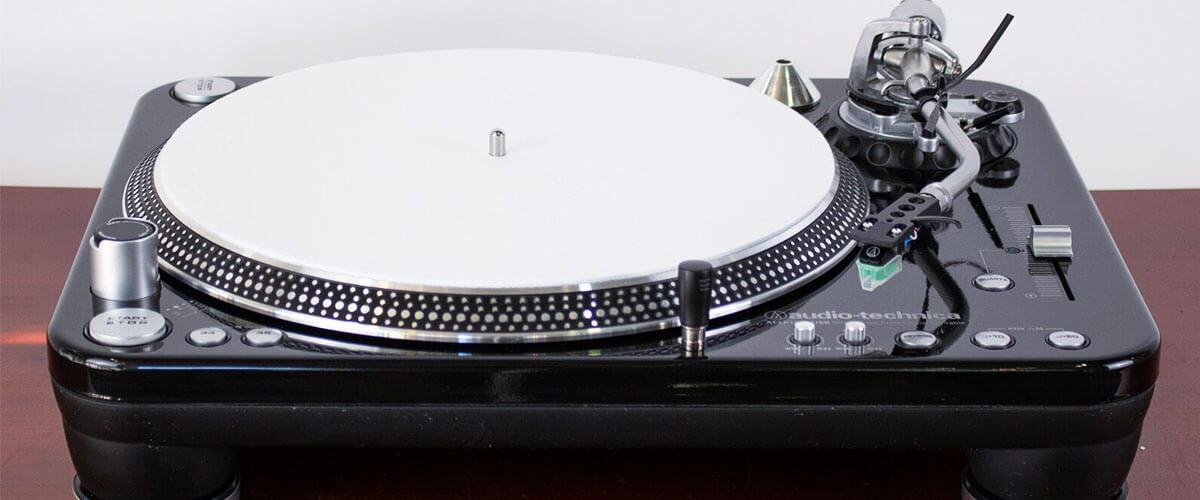
Sound. I was as impressed by the soundstage as I was by the quality of AT-LP1240-USBXP. With dynamics, depth, excellent bass, and fresh upper frequencies, everything is in balance (but I remind you to use an external preamplifier! This is important for the fullness of the experience). Even when replacing the cartridge (for experimentation) with the years-proven Ortofon, I didn’t notice a significant difference.
Audio-Technica AT-LP1240-USBXP tops my chart of best direct drive turntables and is rightfully called by the manufacturer a Professional turntable for DJing. In addition to having all the necessary features for mixing, they also work simply superbly. The soundstage is rich, dynamic, and wide, even with a factory cartridge (which is rare). And the build quality means you can safely experiment at the hottest party. It’s also important to note that you don’t have to choose your records because the turntable works at all three speeds: 33 1/3, 45, and 78 RPM.
The heavy weight of the vinyl turntable is an important factor, and its direct-drive motor is incredibly quiet. Add to this the S-shaped tonearm with a replaceable cartridge, and you get an optimally balanced combination of price, quality, and durability, as upgrades are no problem for the AT-LP1240-USBXP. The USB port lets you connect to your PC to digitalize record tracks.
Key specs
- Drive type: direct.
- Operation type: manual.
- Speeds, RPM: 33 1/3, 45, 78.
- Phono Pre-Amp: yes.
- Bluetooth: no.
- USB: yes.
- Aux input: no.
Pros
- Optimal price/performance ratio in the rating.
- Excellent build quality and heavy, vibration-resistant construction.
- An S-shaped tonearm is considered optimal for vinyl.
- All the features necessary for DJing are present and have proven to be excellent in testing.
- Supports all three rotation speeds: 33 1/3, 45, and 78 RPM.
- The factory cartridge is almost as good as the years-proven Ortofon.
- There is a built-in preamplifier for those who want to save money at first (but still buy an external one later).
Cons
- The anti-skating is a bit weak.
Pioneer DJ PLX-1000 – also great
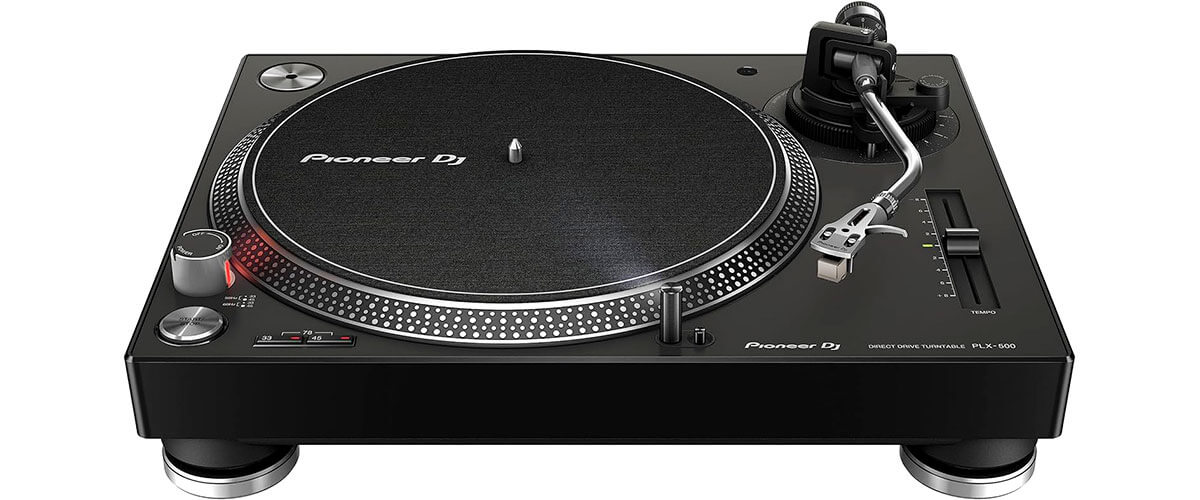
Meet the first twin (well, okay, they are not the same but still very similar) – Pioneer DJ PLX-1000. This turntable is underpriced right now, and that’s why I can offer it as a cheaper alternative to the AT-LP1240-USBXP (but the budget option is still to come). If it costs more (as on the manufacturer’s website), I would never prefer it to the leader of my rating, although their characteristics are identical in almost everything.
While the AT-LP1240-USBXP has a more streamlined shape, the DJ PLX-1000 is characterized by sharp design angles. I can’t say, but I think that when using it in a super-fast club environment, you might well bang your knuckle on it, although the case’s plastic looks nicer than the AT’s. Except for the location of some buttons, everything else is identical. What I didn’t say about the AT-LP1240-USBXP, which I can describe for the PLX-1000, is a fully removable dust cover (which is logical for DJing convenience) and backlighting of some controls. Even the silver tonearm and ornamentation on the platter stand look like they were intentionally meant to be highlighted. I think it’s very comfortable. The weight of the turntable is 28 pounds, and that’s more than enough for a stable setup. All in all, that would be the end of it. But I must warn you that the DJ PLX-1000 is actually manufactured for Pioneer by Hanpin, which is felt in the quality of construction, losing out to the AT’s main competitor.
There is nothing extremely negative to note about the PLX-1000; all the details align with the prospect of active use, except for one thing – to properly utilize the VTA function, you’ll have to buy a thicker slip mat. At least, that’s how I fixed the tonearm alignment problem. In fact, this is a minor bug and not such an additional cost, but still, we are considering an alternative to the winner, which is a clear deviation from the set standard.
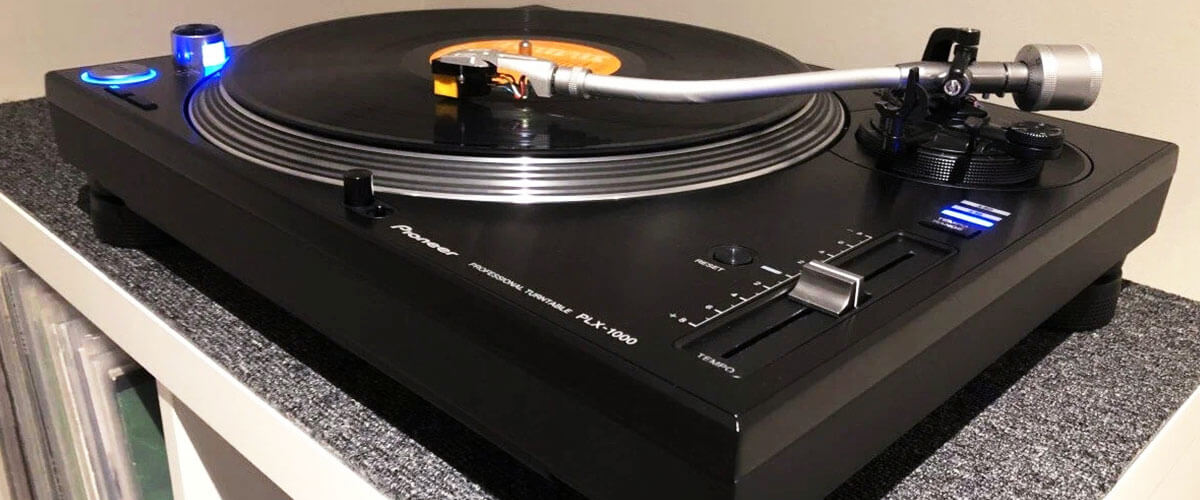
The factory cartridge and built-in preamp (though I’m always skeptical of those) would only be suitable for someone hearing music for the first time. The sound is dull and smeared as if it was passed through a tube resonating in different places (yes, it sounds like that to my ears; you may disagree with me). The picture has certainly changed by replacing components, so the turntable itself wouldn’t be a bad option (otherwise, it wouldn’t be on my list), but it does bode well for the extra cost.
My verdict for the Pioneer DJ PLX-1000 is as follows: If you’re not financially ready to buy the AT-LP1240-USBXP, this model could be a good starter, potentially capable of greater accomplishments. But with the factory built-in preamp and cartridge, you won’t be able to experience the fullness of the analog sound picture, as the DJ PLX-1000 loses out to the more expensive (and popular) leader from Audio-Technica. Perhaps for the reason that Hanpin actually manufactures it.
Nevertheless, in terms of build quality, anti-resonance, torque of 45 kg/cm (accelerates in 0.3 sec like the Audio-Technica leader), and controls, it is perfectly suited for DJ purposes, so I can recommend this direct drive record player to those who are willing to compromise.
Key specs
- Drive type: direct.
- Operation type: manual.
- Speeds, RPM: 33 1/3, 45.
- Phono Pre-Amp: no.
- Bluetooth: no.
- USB: no.
- Aux input: no.
Pros
- DJ-friendly highlighted elements: light-colored tonearm, illuminated buttons.
- The dust cover is also removable for easy DJing.
- Heavy weight provides stability, as it should for a DJ turntable.
- Good torque of 45 kg/cm (accelerates in 0.3 sec).
Cons
- The manufacturer of the DJ PLX-1000 is not Pioneer but Hanpin, which is felt in the quality of construction.
- You will have to seal the mat to align the tonearm with the VTA.
- The soundstage loses significantly to the AT-LP1240-USBXP; you need to spend extra money to improve it.
Technics SL-100C – premium
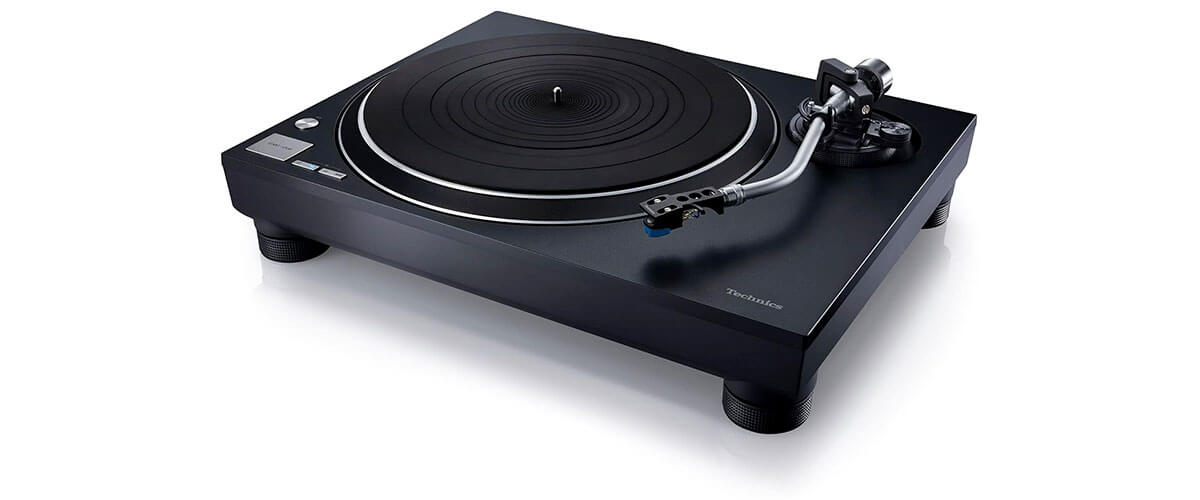
Good direct drive turntable reviews cannot be done without the presence of a model from Technics. The fact is that the first in the series of direct drive record players, the SL-1200, was released in 1972, and since then, it has been a model of stability and quality. All other turntables are based on it, and the Technics SL-100C follows the tradition. It is a premium on both my list and the brand’s range.
It’s the only vinyl turntable that is at least slightly different in appearance from the rest of the chart, but only on cursory inspection. The difference became obvious when I saw the SL-100C in person and even more when I touched it. You will immediately feel that you have a high-level deck in your hands, but I’ll hasten to disappoint DJs: this model has no pitch control (but there are similarly priced turntables for this purpose in the brand’s lineup). At 21.8 pounds, you won’t feel any vibrations, especially since Technics has equipped the vinyl turntable with the brushless front-drive motor it uses for the more expensive SL-1200G and high-end SL-1000R models. Here, softening rubber technology is used across the entire rear surface so there’s no resonance. The chassis is cast aluminum with ABS, fiberglass, and a rubber isolator. It’s been a long time since I’ve dealt with such a quality product (I’ve been testing more of the mid-range and budget segment lately).
As for the tonearm section, it’s executed perfectly, echoing the tradition of the SL-1200 series, and is S-shaped for more accurate sound extraction. But the Auto Lift function is too slow and can take about 40-50 seconds before the record stops. After reading the reviews, I realized this is not an individual case with my sample, so if you’re counting on this option, think twice. On the other hand, I prefer to operate the turntables manually, so I wasn’t confused by this fact. The rest of the functions (break, switching three speeds) work flawlessly.
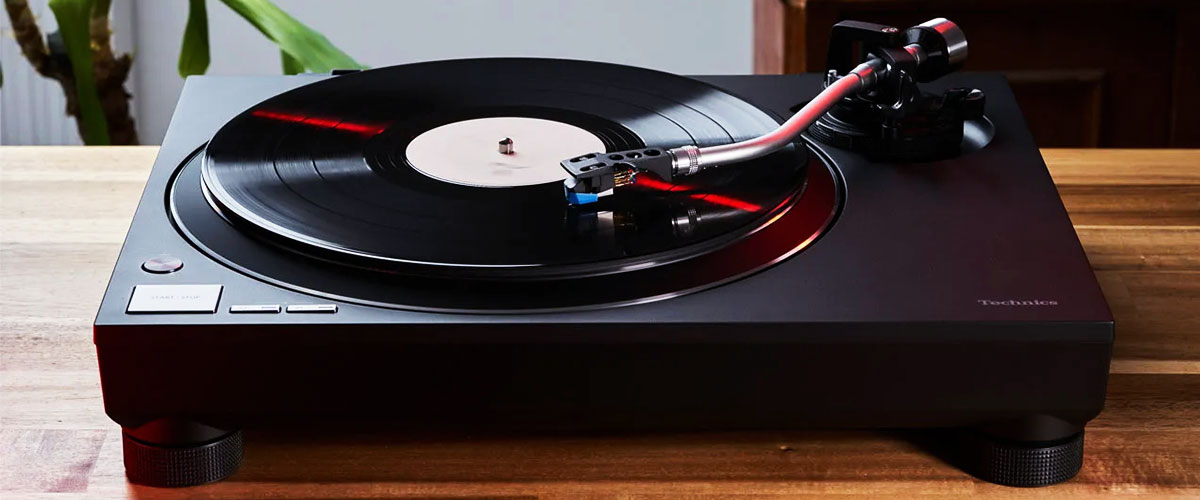
The Audio-Technica AT-VM95C cartridge is worth mentioning. Such cartridges are popular among users of the medium and budget segment, but for a premium model, it seemed unsightly to me. Realizing the potential of the SL-100C, I replaced the cartridge and heard exactly what I expected. The sound is clear and extremely balanced as if all frequencies were specially equalized. Not a single note is out of place, and the bass is perfectly articulated. It seemed most suitable for blues, jazz, and soft rock, as if Technics kept the traditions of the last century, slightly overlooking modern styles and genres (although they are also excellent, just not that much).
I don’t know if you’ve noticed my somewhat reserved tone regarding the Technics SL-100C, but I have a reverent respect for the Technics. If you’re a bit attentive, you’ll even notice that turntables of this brand are used in popular movies (take a closer look at Mission: Impossible – Rogue Nation), so there’s no need to speculate about the brand’s celebrity. Since the SL-100C uses technologies and features of even more expensive models from Technics, the quality of its construction and service life is also not to be doubted.
The turntable’s sound stands out from the rest of the ensemble in my review, raising the bar to a new level. It doesn’t even have a built-in preamplifier, as the manufacturer respects the user too much to provide him with low-quality components. However, this promises additional costs at the initial stage (and the SL-100C is already the most expensive in my rating). I recommend replacing the cartridge (over time) and not using the Auto Lift feature.
Key specs
- Drive type: direct.
- Operation type: manual.
- Speeds, RPM: 33 1/3, 45, 78.
- Phono Pre-Amp: yes.
- Bluetooth: no.
- USB: no.
- Aux input: no.
Pros
- The motor, chassis, and tonearm design utilize the technology of high-end Technics models.
- All the stated functions work perfectly (except Auto Lift).
- The sound picture is wider than that of other participants in the rating.
Cons
- The Auto Lift function works with a delay of up to 1 minute.
- The built-in cartridge Audio-Technica AT-VM95C does not reveal the potential of the turntable.
- The absence of a built-in phono stage promises additional expenses to the already high price of SL-100C (but its absence shows the professional approach of the manufacturer).
Reloop RP-2000 MK2 – budget
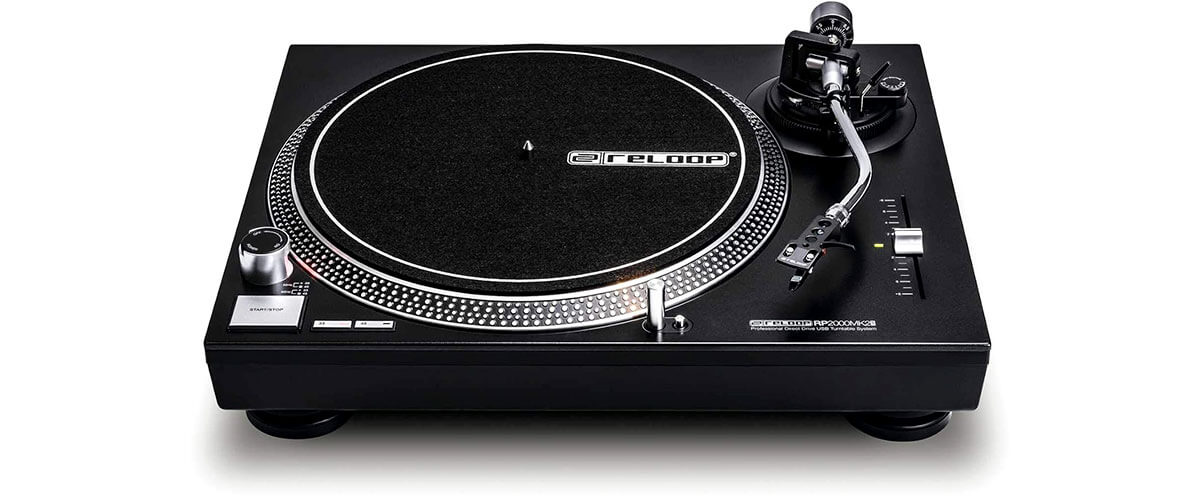
And I’m left to tell you about a budget quartz-driven DJ turntable with a direct drive motor and built-in phono pre-amp. I believe that financial status should not determine what you become in the future, and the Reloop RP-2000 MK2 can be a great starter deck for aspiring DJs.
You won’t notice a difference if you look a few feet away at the Audio-Technica AT-LP1240-USBXP, Pioneer DJ PLX-1000, and the Reloop RP-2000 MK2. Yes, the model under consideration is the second twin of the leader of the selection. Still, according to logic, little by little, it is inferior to its big brother in everything. Let me start with that the deck weighs 14.9 pounds (the case is made of plastic), which is half the weight of any other turntable in my chart. This suggests that you’ll have to watch out for stability and vibrations, but in testing, it didn’t jump around like crazy but stood still even though I moved the speakers farther away. Otherwise, I had no complaints. All significant details on the control panel are backlit so that you won’t get confused in the club’s darkness. They are quite good to the touch (although if you compare the RP-2000 MK2 and AT-LP1240-USBXP standing right next to each other, you can still feel the quality of the latter even when pressing buttons and adjusting), the pitch is very soft, the toe cover is completely removable, the mat doesn’t roll off (although it’s also of lower quality).
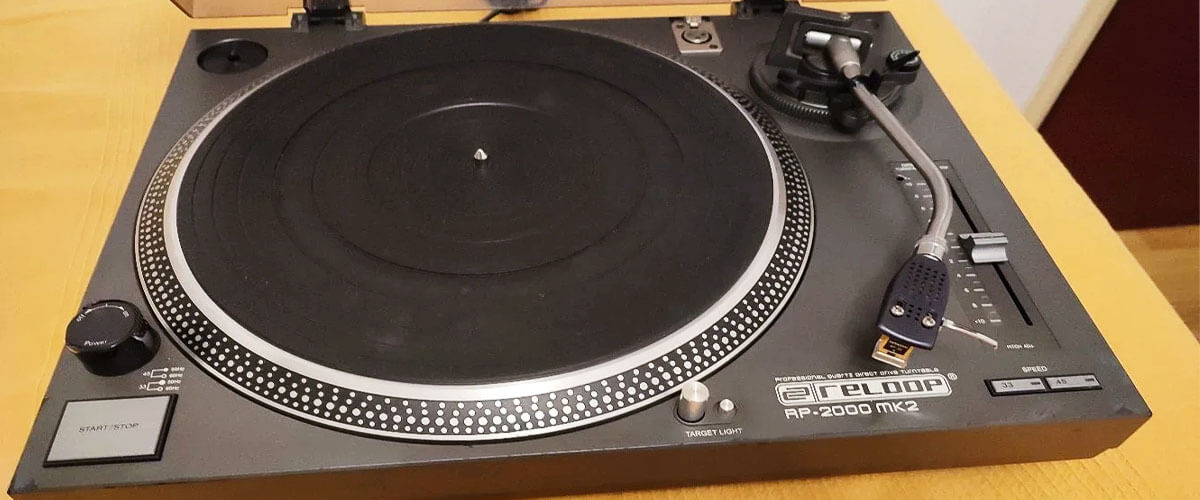
The torque of the turntable is > 1kg/cm, but it is far away from 4,5 kg/cm like Audio-Technica AT-LP1240-USBXP, Pioneer DJ PLX-1000. But for its money, it perfectly copes with the purposes for which it was created. Another of the minuses I would point out is the very light tonearm. With the factory Reloop OM Black cartridge (by Ortofon), the sound is not too impressive (as with all inexpensive turntables). Still, when replacing it with a higher-quality one, I encountered a problem with tonearm equalization. I had to play with a weight. But is it a problem if you want to DJ?
If you understand what you need to count on when buying an inexpensive device, then the Reloop RP-2000 MK2 will fully satisfy you. With a little effort in setting up a little more investment over time, this baby will make even your neighbors dance. I see it in the hands of a teenager infected with the idea of mixing tracks or an amateur DJ, and I think that the turntable deserves attention. Its popularity speaks for itself.
Of course, the difference is obvious if you compare the RP-2000 MK2 with more expensive alternatives, such as Audio-Technica AT-LP1240-USBXP and Pioneer DJ PLX-1000. The cabinet is lighter and worse against vibrations, the tonearm is too light, and you’ll spend time aligning it when replacing the cartridge; there is a lot of plastic in the construction, a mat is too thin, and so on. But the basic features important for DJing (such as a very soft pitch) will not disappoint you at all at first. And it’s the only turntable on my list that doesn’t have a 78 RPM speed (33 1/3 and 45 only).
Key specs
- Drive type: direct.
- Operation type: manual.
- Speeds, RPM: 33 1/3, 45.
- Phono Pre-Amp: yes.
- Bluetooth: no.
- USB: yes.
- Aux input: no.
Pros
- Soft pitch.
- All the conditions for a DJ deck are met.
Cons
- The chassis is made of plastic and weighs 14.9 pounds, half the weight of the competitors on their list.
- The budget-friendly nature of the unit is felt in every detail.
- The very light weight of the tonearm makes it difficult to balance when installing a more expensive cartridge.
- Torque > 1kg/cm is significantly lower than competitors Audio-Technica AT-LP1240-USBXP and Pioneer DJ PLX-1000 (4,5kg/cm).
- It has only two record rotation speeds (33 1/3 and 45 RPM).
Features to consider in direct drive turntables
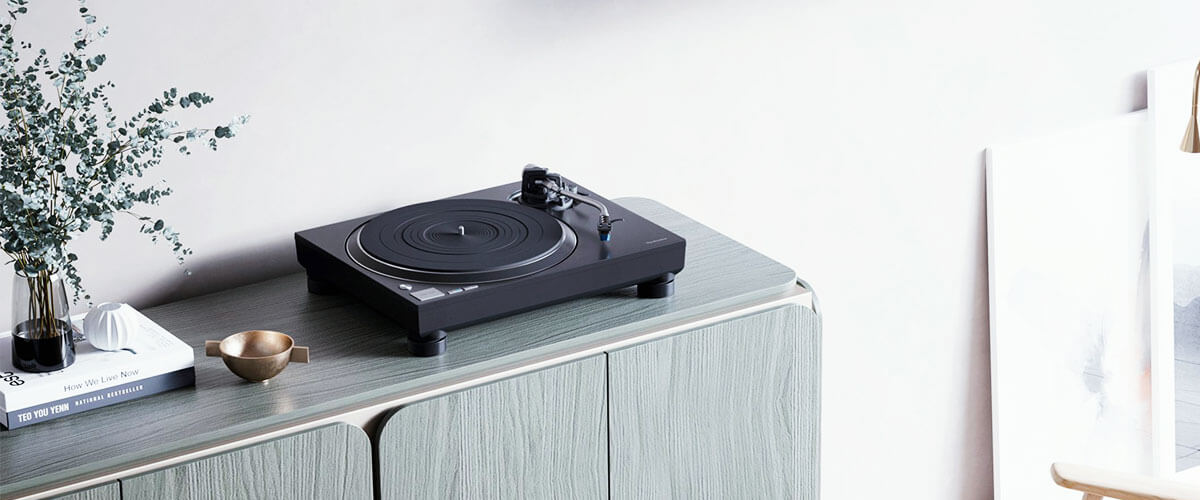
Based on the above reviews, some conclusions can be drawn, including factors to consider when purchasing a direct drive turntable.
- DC brushless motor. This type of motor will provide a long life, requires low maintenance, and has a high torque. But this is important if you are going to do DJing so that other home-use options can be safely considered.
- External control knobs. Again, this is important for DJing more than for home use. Authentic vinyl (audiophiles will tell you) requires care and love as much as a pet, so manual controls are considered a sign of expertise. But for mixing tracks, buttons and quick controls are important. So, a good option is to have pitch control, quartz lock, and automatic speed shifting (imagine standing behind the console and lifting the platter to rearrange the belt).
- Heavy, robust, and stable construction. Here, we are not talking about external vibrations at all but about constant interaction with the turntable in a noisy disco environment. If you plan a vinyl turntable for home use, anti-resonance design is also important, but you can still indulge.
- You may run into automatic control of the tonearm. I don’t see the point of this feature for DJs, but auto-return is good if you have little patience to slowly remove the needle from the record, thus saving both the first and second.
- Anti-skating mechanism and adjustable counterweight. These provide for more precise tuning and extraction of sound from the grooves. The shape of the tonearm is also important here (S-shaped is considered optimal), but I believe such issues should be decided purely individually, depending on your preferences and habits.
- Upgradeability is very important. Parts (especially with heavy use) wear out even in direct-drive turntables, so you should realize that you can replace the cartridge, tonearm, or other parts if they break.
- I added this paragraph only because I understand users, especially beginners. A sophisticated audiophile would consider this “advice” nonsense (believe me, I think so myself), but I will be objective. So, you may be looking for a vinyl player with a built-in phono stage and the ability to record your favorite tracks on a PC (USB port available). This will really save you the initial investment, but as long as my articles are not only reviewing but also a bit educational, let me remind you: a built-in preamplifier of any rank will never be as good as an external one, and digitizing analog sound is bad manners.
In fact, any turntable can give you pleasure if you understand exactly what to expect from it. And there is no bad or good decision when you know what you will use the turntable for. Good luck!
